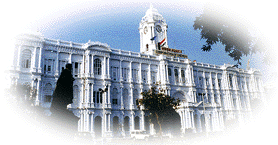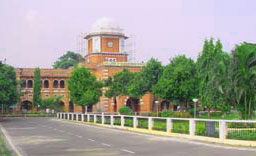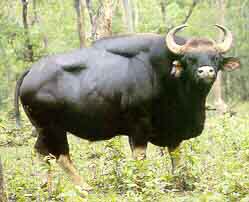| Tamil Nadu Overview |
|||||||||
Forested slopes of the majestic hills of the Western Ghats; profuse incense of the towering temples and gopurams; vibrant festivals of music and dance; shimmering silk fabrics of brilliant colours; endless silver lined beaches. Images conjured at the mention of Tamil Nadu.
Tamil Nadu is bounded by Karnataka and Andhra Pradesh in the north and Kerala in the west. The waters of the Bay of Bengal and the Indian Ocean wash the coastal eastern and southern boundaries respectively. Densely forested uplands, which abound in wildlife, intensively cultivated farmlands interspersed with rocky wastes, mountain chains of the Western Ghats that give way to fertile coastal plains and plateaus form the geographical features of Tamil Nadu. The state is watered by several perennial rain fed rivers and the 760 kilometre long Cauvery travels the entire breadth of the state. Tamil Nadu has a tropical climate without much difference in temperatures in summer and winter. The north-east monsoon brings rain in spurts between October and December. |
About Tamil Nadu • History • Geography • People • Economy • Festivals • Climate
Cities
Travelogues
|
||||||||
At the heart of Dravidian culture and tradition, medieval Tamil Nadu was ruled by four main Dravidian dynasties: Pallavas, Cholas, Pandyas and Chalukyas. The Muslim invasion in the 14th century was followed by Hindu rule of the Pandayas and Nayaks. There was a dominant British presence in the state in the eighteenth and nineteenth century, which led to the creation of the Madras Presidency. In 1947, the presidency was divided on a linguistic basis according to the State Reorganisation Act, following which Madras adopted a new name, Tamil Nadu.
Agriculture is the mainstay of Tamil Nadu's economy and the setting up of automobile plants has taken Tamil Nadu to new heights. The Tamil film industry is now giving Bollywood a run for its money.
Most people speak Tamil, the official state language. Telugu, Kannada, Urdu, and Malayalam are spoken by much smaller percentages. English is spoken as a subsidiary language. The main religions in the state are Hinduism, Christianity, Islam and Jainism. The Chennai metropolitan covering industrial areas, townships and villages surrounding Chennai city, has the largest population but there are other conurbations, of which those around Madurai, Coimbatore, and Tiruchchirappalli are the most important. Festivals are a daily feature in this region. Pongal, Navaratri or Dussehra, Deepavali and Christmas are the popular ones. A unique festival of Carnatic music, the Thyagaraja festival is held annually in January at Thiruvariyar, the birthplace of famous singer poet Thyagaraja, where one can witness the amazing spectacle of mass performance in total harmony and rhythm.
The places of tourist interest in the state are Chennai, the capital city; Mamallapuram the beach resort; Kanchipuram the land of 1000 temples; Madurai famous for the Meenakshi temple; Rameshwaram, Tiruchirapalli and Thanjavur, the temple trio; the charming hill resorts of Yercaud, Ootacamund and Kodaikanal and Kanniyakumari, the southern tip of India, renowned for its fantastic sunrise and sunset.
|
|||||||||
Editor: Romola Butalia (c) India Travelogue. All rights reserved. |
|||||||||


 Tamil Nadu has been a pioneer of peace and knowledge since
time immemorial. The visual legacy of the culture of the state
is among the most satisfying spectacles in India. Tamil
literature is the major source of knowledge about the
administration, art, architecture, economic conditions and
daily life of the people of those times. Among some of the
greatest compositions of the four centuries of the Sangam age
are Thirukkural and Ettuthogai. Tamilians learn to appreciate
culture from a very young age, and have a deep interest in
music, dance and literature. Classical dancing in the form of
Bharatnatyam, has its origin in the temples of the South East
and continues to be followed with a lot of fervour and
dedication in Tamil Nadu. Carnatic music is another art form
that has flourished over the ages, producing artists of great
repute.
Tamil Nadu has been a pioneer of peace and knowledge since
time immemorial. The visual legacy of the culture of the state
is among the most satisfying spectacles in India. Tamil
literature is the major source of knowledge about the
administration, art, architecture, economic conditions and
daily life of the people of those times. Among some of the
greatest compositions of the four centuries of the Sangam age
are Thirukkural and Ettuthogai. Tamilians learn to appreciate
culture from a very young age, and have a deep interest in
music, dance and literature. Classical dancing in the form of
Bharatnatyam, has its origin in the temples of the South East
and continues to be followed with a lot of fervour and
dedication in Tamil Nadu. Carnatic music is another art form
that has flourished over the ages, producing artists of great
repute.
 Tamil Nadu's wildlife sanctuaries like Madumalai and Annamalai
(Indira Gandhi wild life sanctuary) are situated in the hills
of the Western Ghats and are the habitat of elephants, tigers,
bisons and a variety of monkey and deer.
Tamil Nadu's wildlife sanctuaries like Madumalai and Annamalai
(Indira Gandhi wild life sanctuary) are situated in the hills
of the Western Ghats and are the habitat of elephants, tigers,
bisons and a variety of monkey and deer.